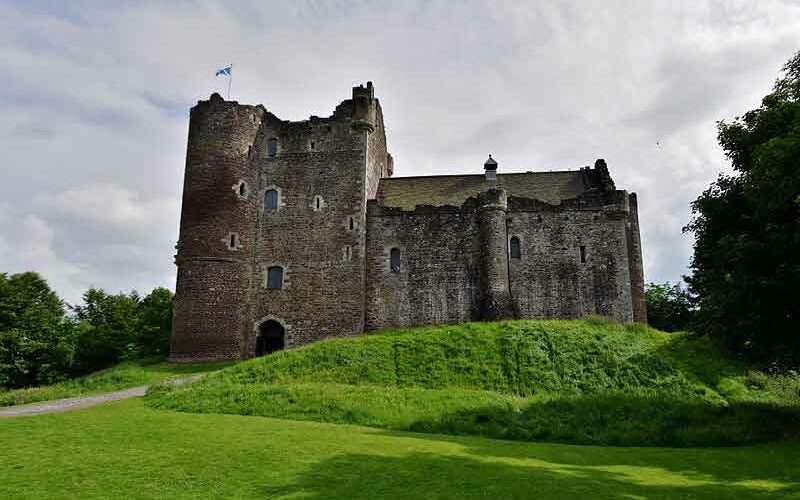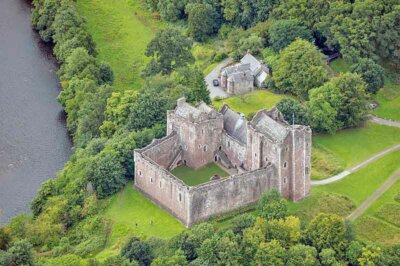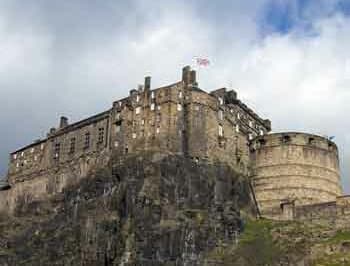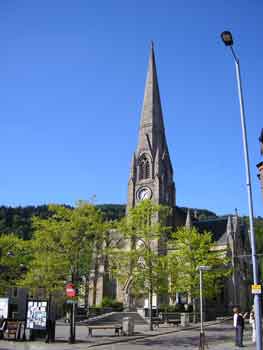
Although Doune Castle may well be better known for its role in the Outlander series, it has a history stretching back centuries.
The history of Doune Castle, Scotland
The story of the castle and the people associated with the surrounding area will take you on a remarkable journey from Scotland to the battlefields of the American War of Independence.
Doune Castle noted one 19th century writer, “is a very striking and imposing structure, a prodigious stronghold, which presents a venerable aspect and is very conspicuous in the surrounding country.”
The castle was and still is all of the above but as the residence of Robert, first Duke of Albany, one of Scotland’s most powerful men.
It was also the prison of John Witherspoon one of the signatories to the American Declaration of Independence, it was much more than just an impressive architectural pile.
This historic Scottish castle, which stands on a promontory where the River Teith on the west and the Ardoch Burn on the east meet, lies close to the village of Doune, about eight miles from Stirling.
The first reference (extant) to it dates to 1381 in a letter written in “Dwne in Menteith.”
Roman fort
Although it’s a matter of some contention, second-century geographer Ptolemy identified the location as Tamia. Others however suggest Tamia may have been further north, perhaps Perth.
Thanks to aerial reconnaissance and archaeological excavations there is more solid evidence of prehistoric occupation and a later Roman fort and hospital almost certainly built by Agricola during his invasion of what was then Northern Britain.
Sir Walter Scott was a particular admirer of the castle often passing close as he visited friends who lived by the River Teith.
Unsurprisingly it makes an appearance in a number of his books including Lady of the Lake and Waverley. He said, “This noble ruin is dear to my recollection from associations which have been long and painfully broken…”
Although the castle physically, historically and emotionally dominates the area, the story of the nearby village deserves some exploration too.
Cattle drovers
In the late 18th century Doune, its name derived from ‘dun’ meaning an ancient stronghold, was both the site of an important cattle tryst and a stopping point on the long and difficult journey from the north-west Highlands.
This route brought the cattle drovers by way of Glen Ogle, Balquhidder and Loch Lubnaig to Callander and Doune before continuing to the market at Falkirk.
It was the unlikely home of the Murdoch Pistol Factory where the manufacturing process was first begun in 1646 by Thomas Caddell whose ornately engraved pistols were owned by Louis XIV of France, Peter the Great of Russia and a number of Scotland’s nobility, to name only a few.
Lexington Historical Society
Perhaps the most famous pistols lovingly crafted at the Doune factory are now in the possession of the Lexington Historical Society in Lexington Massachusetts.
The guns now known as the Pitcairn pistols once belonged to Royal Marine officer, Major John Pitcairn, a Scot from Dysart in Fife, second in command of the British force that entered Lexington In April 1775.
The exchange of fire, between the British and local militiamen is considered the first military engagement of the American War of Independence.

At some point, Pitcairn lost the pistols which were later used by the distinguished, American general Israel Putnam against the British. Although some historians now cast doubt on some elements of the story, the legend endures.
The prosperity of the village owes much to its castle which dates to the 1260s, the time of Walter Stewart who acquired the earldom of Menteith and the castle through marriage.
A close inspection clearly reveals evidence of that 13th century construction, particularly in parts of the gatehouse and kitchen tower.
Duke of Albany
However, much of what we see today was built or re-structured by Robert Stewart (c. 1340-1420), Earl of Menteith, Earl of Fife and the first Duke of Albany, a title he took, in a ceremony at Scone Abbey in April 1398.
In 1361 Albany married Margaret Graham, Countess of Menteith a lady described by S.I.Boardman as a “prestigious and lucrative wife.”
The countess was no stranger to married life having had three previous husbands. The earliest extant record which shows Robert styled as “of Menteith,” dates to May 1363.
In the last months of 1384, Robert Stewart planned a bloodless coup against his father King Robert II and was subsequently appointed Guardian of the Kingdom by a council which met in Edinburgh in November.
When Robert II died in April 1390, Albany’s brother John, Earl of Carrick took the throne as Robert III. However political circumstances, a convenient euphemism for Albany’s ruthless pursuit of power, combined with the new king’s ill health allowed Albany to continue as Guardian.
The Wolf of Badenoch
Albany’s single-minded determination to succeed, whatever the cost, was a trait found in other members of his family, particularly his brother Alexander Stewart, 1st Earl of Buchan better known as the Wolf of Badenoch who many regard as Scotland’s most unpleasant historical character.
It is however a little confusing having two brothers called Robert in the same family. Although Carrick was christened John, he took the name Robert to avoid any comparison with the unpopular King John Balliol.
There is no record in the Exchequer Rolls (which are not complete) of any government payments for the construction of the castle so It seems likely that Albany, rather than the crown, paid for the work. Certainly, there was some agreement from chronicler Walter Bower who described Albany as a “big spender.”

There are suggestions that Nicholas of Hane, the king’s mason, was brought in to advise on the construction of a building which may have been influenced by the great French chateau of Pierrefonds built by the Duke of Orleans c. 1390 -1410.
There are also similarities to a number of other courtyard castles in Scotland including, Dirleton, Tantallon and Caerlaverock.
The castle may have acted as the administrative centre for the Menteith estates and as keeper of nearby Stirling Castle,
Albany would certainly have visited Doune frequently. A number of charters issued by him from Doune between 1406 and 1413 are seen as confirmation of his regular attendance.
Albany often held ‘court’ at Doune which meant there would have been a number of influential men at the castle. While records tell us that this is the case, it’s a scenario that leaves historians with a conundrum.
Historian Richard Oram agreed that Albany would not have been happy with the layout that still survives today.
He said, “Such gatherings could not have been accommodated comfortably and with the dignity expected of men of their status in the limited space which the visible remains represent.”
To reinforce his arguments Oram points to 10 February 1407 when Albany received the Chancellor of Scotland, Gilbert Greenlaw the Bishop of Aberdeen, Sir William Airth, Sir William Graham and others. All would have arrived with their entourage.
The answer to this obvious lack of space may lie with the castle’s south and west ranges. Although there is some documentation that mentions the ranges, there is no physical evidence and consequently, some question their existence.
The problem of lack of space again arose for the planned visit of the young James VI in 1581, the castle was still deemed to be, “defective in bedroom and servants’ accommodation.” So it seems even after a century and a half, the problem of where to put the guests was still unresolved.
Historic Environment Scotland (previously considered some possible explanations: “the south and west ranges were never built; the ranges were built but subsequently destroyed and neatly cleaned up.”
It’s an intriguing and much debated puzzle; one which only further detailed archaeological investigation will answer.
Royal castles in Scotland
Despite the arguments over the accommodation, there is some agreement that the standard of accommodation at Doune was of equal quality to other royal castles in Scotland.
Battle of Homildon Hill
In 1402 the Battle of Homildon Hill pitched Archibald Earl of Douglas against the forces of Henry Percy, the Earl of Northumberland. Albany’s son Murdoch Stewart was taken prisoner and spent the next 13 years of his life becoming acquainted, as a ‘guest’ of Henry IV and Henry V, with the Tower of London.
The short battle was immortalized in William Shakespeare’s Henry IV, part 1.
For some of that time, he had the company of the young King James I who was also the reluctant recipient of English hospitality.

James, despite being a prisoner, had succeeded his father Robert III who died in 1406. During his captivity he was slowly integrated into the English court, learning the art of kingship and politics from the House of Lancaster.
With Robert’s death and the absence of James, Albany was again appointed Governor of the Kingdom at a council at Perth.
Finally, in 1415 Albany arranged Murdoch’s release but the ransom demanded for James was not paid and he remained in England.
The priority for Albany was his son and heir and his decision not to help James return to Scotland unsurprisingly infuriated the king. Of course the king’s return would have meant the end of Albany’s governorship and perhaps his life too.
Albany died in September 1420 in Stirling Castle and was buried in Dunfermline Abbey. Doune Castle and surrounding estate passed to Murdoch who became the second Duke of Albany. Within weeks he was also the Governor of Scotland.
Walter Bower made an interesting comparison between Murdoch and his father Robert. He described Murdoch as, “too slack in the exercise of this office… and unable to control his arrogant sons.” Certainly, there was an open and well-documented conflict with his son Walter who had ambitions of his own.
More Scottish history articles
In April 1424 James I finally returned to Scotland to take his throne and his revenge. In May his coronation and first parliament took place at Scone providing a reminder to his countrymen, should it be needed, that royal authority was now restored.
Within months leading male members of the Albany family were put to death including Murdoch the second duke who was executed in Stirling in May 1425. With his death the earldom of Menteith was annexed and the castle became a crown possession.
Because of the castle’s proximity to the Braes of Menteith and the forests of Glenfinglas It became a popular hunting retreat for a number of monarchs, with James II, III, IV, and VI often visiting. It was too a dower house for Mary of Gueldres, Margaret of Denmark, Margaret Tudor and Mary of Guise.
Seige of Doune Castle
In the only recorded siege in the castle’s history, it was, following the forced abdication of Mary Queen of Scots in 1567, besieged for three days by her enemies.
Finally, her supporters agreed to surrender on the condition the castle was not destroyed. Did Mary ever visit Doune?
Her bedchamber in the castle might suggest she was there however like many other things associated with the castle, it is a matter of debate.
During the Jacobite rising of 1745, the castle was held by men, led by John MacGregor of Glengyle, loyal to the cause of Prince Charles Edward Stuart.
It was used as a prison to hold government supporters including a number taken at the Battle of Falkirk, fought in January 1746 only a few months before the final major confrontation on Culloden Moor.
Declaration of Independence
Among them were playwright and historian John Home who had joined the pro- Hanoverians College Company of Volunteers (associated with the University of Edinburgh) and John Witherspoon who later emigrated to the United States.
Witherspoon became the president of the Presbyterian College of New Jersey, later Princeton University and signatory to the Declaration of Independence.
Home later published the story of the group’s captivity and their daring escape, using knotted blankets to climb down the castle walls, in The History of the Rebellion in Scotland in 1745.
It’s an interesting book in which Home wrongly attributes the building of the fortress to Murdoch Stewart.
He does give a description of the unpleasant conditions in which the prisoners were held. He said the castle was in “a most ruinous condition… The place of their abode was a large ghastly room, the highest part of the castle, next to the battlements… to guard the prisoners there was a party of twenty or twenty-five Highlanders.”
Home also mentions Witherspoon, suggesting he was an onlooker to the battle rather than a participant.
Historic Environment Scotland takes a different view on Witherspoon’s involvement arguing he was also one of the Company of Volunteers, “hoping to defend the government against the Jacobites.”
Whatever the truth it remains unclear if Witherspoon was part of the group which escaped.
As the castle slowly fell into ruin it became one of Scotland’s early tourist attractions.
The local newspaper, the Stirling Observer noted in 1859 that, “scarcely a day passes without large parties of travellers surrounding it… and every nook and corner of the building is pregnant with strange historical reminiscences.”
During the 1880s, Doune Castle was restored to its current state by the fourteenth Earl of Moray and finally entrusted into state care by Douglas John Stuart, the twentieth Earl of Moray in 1984. Today the castle is managed by Historic Environment Scotland.
Diana Gabaldon Outlander
Despite an impressive historical legacy, the memories of those tumultuous days when the Duke of Albany ruled Scotland and called Doune home have faded just a little.
The castle, which needs to survive in a competitive modern world, has, after an audition stretching over seven and a half centuries, quietly slipped into a new role as one of the country’s best-known film locations.
It is to the many fans of Diana Gabaldon’s Outlander better known as the fictional Castle Leoch.
Doune Castle: visitor information
For information on opening hours, cost of entry and other tips to help you plan your visit, go to the official castle website.